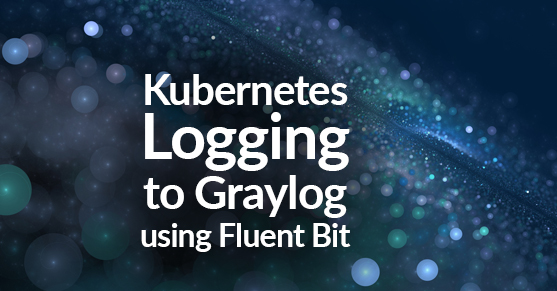Fluent Bit is deployed as a daemonset in Kubernetes, allowing it to run on every node in the cluster. This makes it easy to not worry about reconfiguring Fluent Bit for any new nodes added to the Kubernetes cluster. Fluent Bit supports multiple inputs, outputs, and filter plugins depending on the source, destination, and parsers involved with log processing. For example, the Tail input plugin reads every log event from one or more log files or containers in a manner similar to the UNIX tail -f command. On the output side, the GELF (Graylog Extended Log Format) output plugin sends logs in GELF format to the Graylog server. The Kubernetes filter plugin supplements logs by extracting metadata like Container Name, Container ID, POD Name, Namespace, Labels, and Annotations from the Kubernetes API server, decorating log data with those additional pieces of information.
Fluent Bit Installation
In order to install Fluent Bit, a Kubernetes cluster must be running. You must also have kubectl installed and configured to access the Kubernetes cluster. Finally, it’s necessary to have a Graylog server setup with GELF TCP input and connectivity allowed to the GELF TCP input port from all the Kubernetes nodes.
Here are the steps to create and configure Fluent Bit as a Kubernetes Daemonset.
1. Use kubectl to create the logging namespace, service account, and role-based access control configuration.
sh-4.2$ kubectl create namespace logging
sh-4.2$ kubectl create -f https://raw.githubusercontent.com/fluent/fluent-bit-kubernetes-logging/master/fluent-bit-service-account.yaml
sh-4.2$ kubectl create -f https://raw.githubusercontent.com/fluent/fluent-bit-kubernetes-logging/master/fluent-bit-role.yaml
sh-4.2$ kubectl create -f https://raw.githubusercontent.com/fluent/fluent-bit-kubernetes-logging/master/fluent-bit-role-binding.yaml2. Update the sample fluent-bit-cm.yaml file with the target Graylog server and GELF TCP input port. Customize and tweak the input plugin corresponding to the environment. Note that in some scenarios, the default Fluent Bit DB flb_kube.db name can cause conflict with New Relic APM, which also relies on Fluent Bit for monitoring purposes. Filter plugin attributes can also be adjusted depending on what Kubernetes metadata needs to be included with the logs.
fluent-bit-cm.yaml
apiVersion: v1
kind: ConfigMap
metadata:
name: fluent-bit-config
namespace: logging
labels:
k8s-app: fluent-bit
data:
# Configuration files: server, input, filters and output
# ======================================================
fluent-bit.conf: |
[SERVICE]
Flush 1
Log_Level info
Daemon off
Parsers_File parsers.conf
HTTP_Server On
HTTP_Listen 0.0.0.0
HTTP_Port 2020
@INCLUDE input-kubernetes.conf
@INCLUDE filter-kubernetes.conf
@INCLUDE output-graylog.conf
input-kubernetes.conf: |
[INPUT]
Name tail
Tag kube.*
Path /var/log/containers/*.log
Parser docker
DB /var/log/flb_graylog.db
DB.Sync Normal
Docker_Mode On
Buffer_Chunk_Size 512KB
Buffer_Max_Size 5M
Rotate_Wait 30
Mem_Buf_Limit 30MB
Skip_Long_Lines On
Refresh_Interval 10
filter-kubernetes.conf: |
[FILTER]
Name kubernetes
Match kube.*
Merge_Log On
Merge_Log_Key log
Keep_Log Off
K8S-Logging.Parser On
K8S-Logging.Exclude Off
Annotations Off
Labels On
output-graylog.conf: |
[OUTPUT]
Name gelf
Match *
Host
Port
Mode tcp
Gelf_Short_Message_Key log
parsers.conf: |
[PARSER]
Name apache
Format regex
Regex ^(?<host>[^ ]*) [^ ]* (?<user>[^ ]*) \[(?<time>[^\]]*)\] "(?<method>\S+)(?: +(?<path>[^\"]*?)(?: +\S*)?)?" (?<code>[^ ]*) (?<size>[^ ]*)(?: "(?<referer>[^\"]*)" "(?<agent>[^\"]*)")?$
Time_Key time
Time_Format %d/%b/%Y:%H:%M:%S %z
[PARSER]
Name apache2
Format regex
Regex ^(?<host>[^ ]*) [^ ]* (?<user>[^ ]*) \[(?<time>[^\]]*)\] "(?<method>\S+)(?: +(?<path>[^ ]*) +\S*)?" (?<code>[^ ]*) (?<size>[^ ]*)(?: "(?<referer>[^\"]*)" "(?<agent>[^\"]*)")?$
Time_Key time
Time_Format %d/%b/%Y:%H:%M:%S %z
[PARSER]
Name apache_error
Format regex
Regex ^\[[^ ]* (?<time>[^\]]*)\] \[(?<level>[^\]]*)\](?: \[pid (?<pid>[^\]]*)\])?( \[client (?<client>[^\]]*)\])? (?<message>.*)$
[PARSER]
Name nginx
Format regex
Regex ^(?<remote>[^ ]*) (?<host>[^ ]*) (?<user>[^ ]*) \[(?<time>[^\]]*)\] "(?<method>\S+)(?: +(?<path>[^\"]*?)(?: +\S*)?)?" (?<code>[^ ]*) (?<size>[^ ]*)(?: "(?<referer>[^\"]*)" "(?<agent>[^\"]*)")?$
Time_Key time
Time_Format %d/%b/%Y:%H:%M:%S %z
[PARSER]
Name json
Format json
Time_Key time
Time_Format %d/%b/%Y:%H:%M:%S %z
[PARSER]
Name docker
Format json
Time_Key time
Time_Format %Y-%m-%dT%H:%M:%S.%L
Time_Keep On
[PARSER]
Name syslog
Format regex
Regex ^\<(?<pri>[0-9]+)\>(?<time>[^ ]* {1,2}[^ ]* [^ ]*) (?<host>[^ ]*) (?<ident>[a-zA-Z0-9_\/\.\-]*)(?:\[(?<pid>[0-9]+)\])?(?:[^\:]*\:)? *(?<message>.*)$
Time_Key time
Time_Format %b %d %H:%M:%S3. Create a Kubernetes ConfigMap named fluent-bit-config using the following command:
sh-4.2$ kubectl create -f fluent-bit-cm.yaml4. Update the fluent-bit image in the following yaml to the most recent version available on Docker Hub.
fluent-bit-graylog-ds.yaml
apiVersion: apps/v1
kind: DaemonSet
metadata:
name: fluent-bit
namespace: logging
labels:
k8s-app: fluent-bit-logging
version: v1
kubernetes.io/cluster-service: "true"
spec:
selector:
matchLabels:
k8s-app: fluent-bit-logging
template:
metadata:
labels:
k8s-app: fluent-bit-logging
version: v1
kubernetes.io/cluster-service: "true"
annotations:
prometheus.io/scrape: "true"
prometheus.io/port: "2020"
prometheus.io/path: /api/v1/metrics/prometheus
spec:
containers:
- name: fluent-bit
image: fluent/fluent-bit:1.3.10
imagePullPolicy: Always
ports:
- containerPort: 2020
volumeMounts:
- name: varlog
mountPath: /var/log
- name: varlibdockercontainers
mountPath: /var/lib/docker/containers
readOnly: true
- name: fluent-bit-config
mountPath: /fluent-bit/etc/
terminationGracePeriodSeconds: 10
volumes:
- name: varlog
hostPath:
path: /var/log
- name: varlibdockercontainers
hostPath:
path: /var/lib/docker/containers
- name: fluent-bit-config
configMap:
name: fluent-bit-config
serviceAccountName: fluent-bit
tolerations:
- key: node-role.kubernetes.io/master
operator: Exists
effect: NoSchedule
- operator: "Exists"
effect: "NoExecute"
- operator: "Exists"
effect: "NoSchedule"5. Create a Daemonset using the fluent-bit-graylog-ds.yaml to deploy Fluent Bit pods on all the nodes in the Kubernetes cluster.
sh-4.2$ kubectl create -f fluent-bit-graylog-ds.yaml6. Verify that the fluent-bit pods are running in the logging namespace.
sh-4.2$ kubectl get po -o wide -n logging7. Verify Kubernetes logs and metadata are reporting to the Graylog server instance.
Conclusion
The advantage of Fluent Bit is its capability to run with very minimal resources efficiently and with very high performance when compared to the competing Fluentd log ingester. It also provides value by offering plugins for most commonly used systems, including output filters for systems like Elasticsearch, Apache Kafka, and Splunk.
If you have questions on how you can best leverage Kubernetes, or are looking for help with your Kubernetes-based implementation, please engage with us via comments on this blog post, or reach out to us here.
Additional Reading
Additional questions regarding Kubernetes? Check out Kubernetes – Container Health Checks or for AWS-specific details, take a look at Setting up EKS Cluster AutoScaler or The Definitive Guide to Setting Up Prometheus with Grafana Integration for EKS. If you have questions about cloud provisioning in general, run through our summary on the Top Ten Best Practices for Terraform Implementations.

